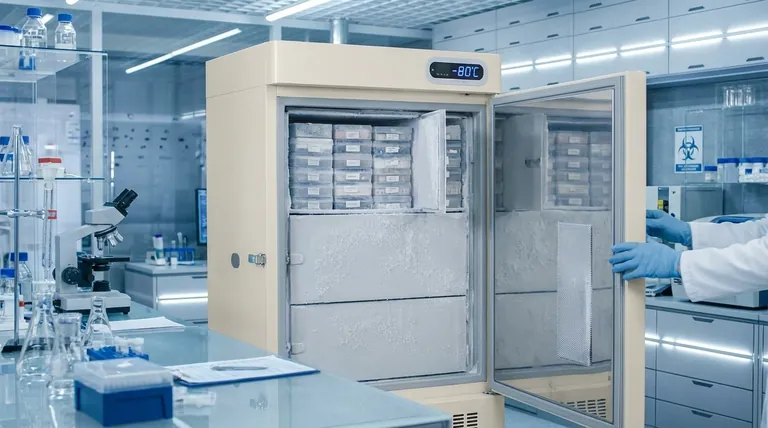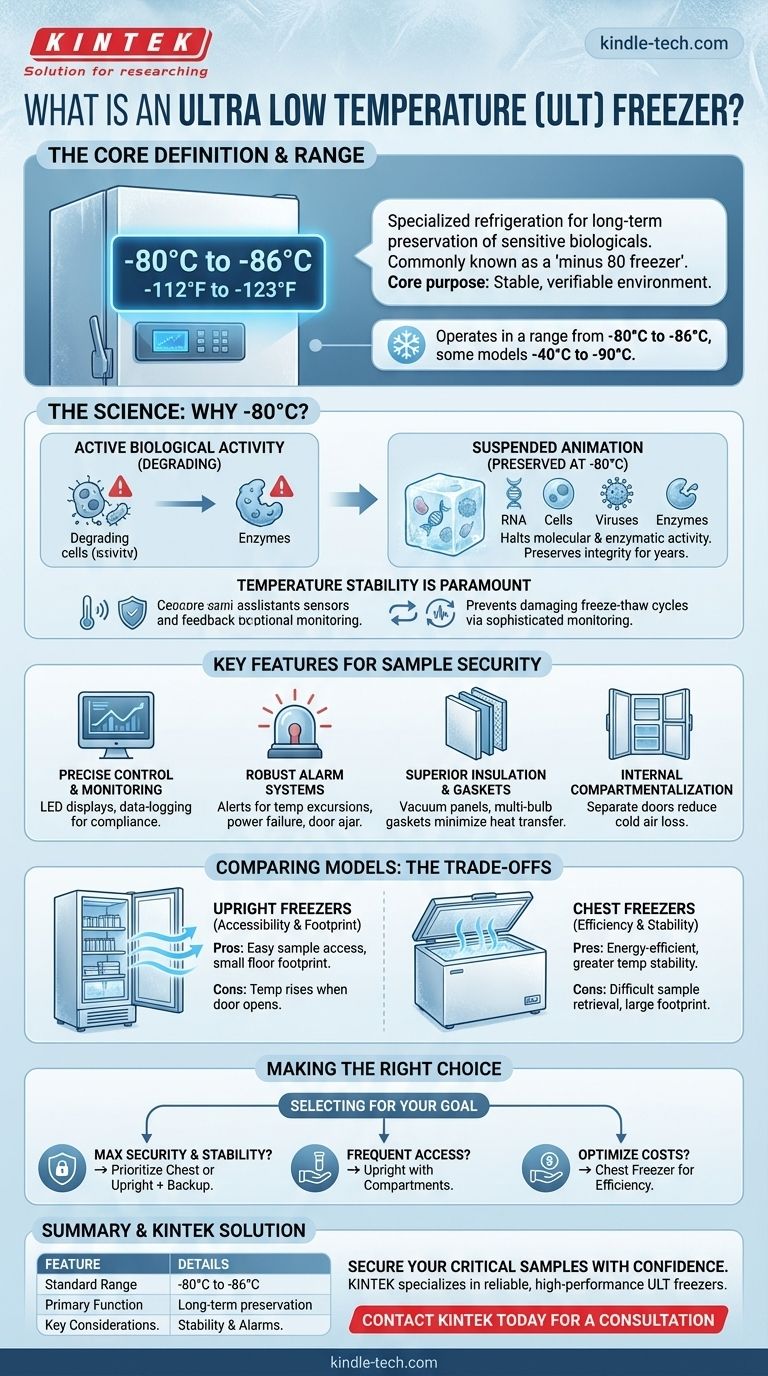An ultra low temperature (ULT) freezer is a specialized refrigeration unit designed to store sensitive biological materials at exceptionally cold temperatures. Unlike a standard freezer, a ULT freezer typically operates in a range from -80°C to -86°C (-112°F to -123°F), with some models capable of maintaining temperatures between -40°C and -90°C. It is most commonly known as a "minus 80 freezer" due to this industry-standard temperature.
The core purpose of a ULT freezer is not just to be cold, but to provide an extremely stable and verifiable environment. This stability is critical for halting nearly all biological activity, thereby preserving the integrity of irreplaceable samples for long-term storage and research.

The Core Function: Beyond Simple Freezing
The extreme cold of a ULT freezer serves a very specific scientific purpose: long-term biological preservation. At these temperatures, the molecular and enzymatic activity that leads to sample degradation is effectively stopped.
Why -80°C is the Standard
This temperature is significantly below the freezing point of water and other biological fluids. Maintaining samples at or below -80°C ensures that even the most sensitive components—such as RNA, enzymes, viruses, and cell lines—remain in a state of suspended animation, preserving their viability and structure for years.
The Principle of Temperature Stability
Achieving a low temperature is only half the battle; maintaining it is paramount. ULT freezers use a sophisticated system of sensors, control algorithms, and feedback loops to constantly monitor and adjust the internal climate. This ensures the temperature remains exceptionally stable, preventing the damaging freeze-thaw cycles that can occur with minor fluctuations.
Common Applications and Industries
Due to their specialized function, ULT freezers are essential equipment in many fields. They are frequently used in hospitals, blood banks, research institutes, and biomedical engineering facilities to store critical materials like:
- Vaccines and drugs
- Tissues, cells, and bacteria
- Proteins and enzymes
- Other vital biological specimens
Key Features of a High-Performance ULT Freezer
When evaluating a ULT freezer, several features are critical for ensuring the security and integrity of the materials stored inside.
Precise Temperature Control and Monitoring
The most fundamental feature is a reliable control system. Look for units with clear LED displays that show the internal temperature and any alarm codes, ensuring you can verify performance at a glance. Many also offer data-logging or chart-recording capabilities for compliance and record-keeping.
Robust Alarm Systems
Because the contents are often priceless, a robust alarm system is non-negotiable. These systems provide audible and visual alerts for temperature excursions (becoming too warm or too cold), power failures, or a door left ajar, allowing for immediate corrective action.
Superior Insulation and Gaskets
To maintain such low temperatures efficiently, high-quality vacuum-insulated panels and multi-bulb door gaskets are essential. This advanced insulation minimizes heat transfer, which reduces energy consumption and protects samples in the event of a power outage.
Internal Compartmentalization
Most upright ULT freezers contain separate internal compartments, each with its own door. This design minimizes the loss of cold air when the main door is opened, protecting samples in other compartments from temperature fluctuations.
Understanding the Trade-offs: Upright vs. Chest Models
ULT freezers are available in two primary formats, each with distinct advantages and disadvantages.
Upright Freezers: Accessibility and Footprint
Upright models are the most common choice for laboratories. Their shelving and internal doors make it easy to organize and quickly access specific samples. They also typically have a smaller floor footprint, which is a key consideration in crowded lab spaces.
However, opening the door allows cold, dense air to flow out, causing a temporary temperature increase and requiring the system to work harder to cool back down.
Chest Freezers: Efficiency and Stability
Chest freezers are inherently more energy-efficient. Because the lid is on top, cold air does not "fall out" when it's opened, leading to greater temperature stability and lower operating costs.
The primary drawback is accessibility. Locating and retrieving samples from a deep, layered chest freezer can be difficult and time-consuming, and they require a larger floor footprint than upright models.
Making the Right Choice for Your Goal
Selecting a freezer depends on balancing sample security, lab workflow, and operational budget.
- If your primary focus is maximum sample security and long-term stability: Prioritize a chest freezer or an upright model with a CO2 or LN2 backup system and robust temperature monitoring.
- If your primary focus is frequent sample access and organization: An upright model with high-quality internal compartments is the most practical choice for an active workflow.
- If your primary focus is optimizing operational costs: Compare the energy efficiency ratings of different models and consider a chest freezer for its inherent efficiency advantages.
Ultimately, selecting the right ULT freezer is an investment in the integrity and security of your most critical work.
Summary Table:
| Feature | Key Details |
|---|---|
| Standard Temperature Range | -80°C to -86°C (-112°F to -123°F) |
| Primary Function | Long-term preservation of sensitive biological materials |
| Common Applications | Storing vaccines, tissues, cells, enzymes, and more |
| Key Considerations | Temperature stability, alarm systems, energy efficiency, and accessibility (upright vs. chest models) |
Secure your critical samples with confidence. Choosing the right ULT freezer is vital for protecting your research and valuable biological materials. KINTEK specializes in providing reliable lab equipment, including high-performance ULT freezers, to meet the precise demands of laboratories, hospitals, and research institutes. Our experts can help you select the ideal model for your sample security, workflow, and budget.
Contact KINTEK today for a personalized consultation and ensure the integrity of your work.
Visual Guide

Related Products
- 158L Precision Vertical Ultra Low Freezer for Laboratory Applications
- 508L Advanced Vertical Ultra Low Temperature Freezer for Critical Laboratory Storage
- 938L Vertical Ultra Low Temperature Freezer for Advanced Laboratory Storage
- 808L Precision Laboratory Vertical Ultra Low Temperature Freezer
- 408L Advanced Vertical Laboratory Ultra Low Temperature Freezer for Critical Research Material Preservation
People Also Ask
- What features do ultra-low temperature freezers typically include? Ensuring Absolute Sample Security
- How do Ultra-Low Temperature freezers ensure the integrity of microbiological samples? Maintain Stability for Critical Research
- What are ultra-low temperature freezers designed for? Preserving Your Most Valuable Biological Samples
- What are ultra low temperature freezers used for? Preserving Critical Biological Samples for Decades
- Where are ultra low temperature freezers commonly used? Essential for Labs, Hospitals, and Biotech



















